| (insert your NIE or newspaper logo here) |
Weekly Online LessonOnline Lesson ArchiveGrade Level: 6-12
|
Managing Wildfire
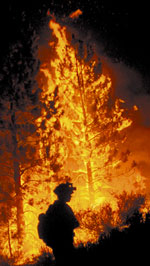 Wildfires
took off this week, with the Aspen Fire scorching over 7,500 acres since
Tuesday, June 17, 2003. The Arizona wildfire, ignited northwest of Tucson
near Mount Lemmon, has so far destroyed at least 250 buildings, including
many homes. Arizona's Aspen Fire is the year's single largest to date,
while smaller fires are burning in Florida, Alaska, California, Nevada
and New Mexico.
Wildfires
took off this week, with the Aspen Fire scorching over 7,500 acres since
Tuesday, June 17, 2003. The Arizona wildfire, ignited northwest of Tucson
near Mount Lemmon, has so far destroyed at least 250 buildings, including
many homes. Arizona's Aspen Fire is the year's single largest to date,
while smaller fires are burning in Florida, Alaska, California, Nevada
and New Mexico.
Although wildfires can be destructive, they are also essential to maintain healthy ecosystems. In some areas, for example, evidence from tree rings suggests that wildfires regularly swept through about every 10 years. However, since about the 1950s, the federal government generally sought to extinguish every forest fire as soon as it was reported.
What seemed like a good idea at the time has allowed some areas to accumulate heavy loads of dead plant material. This is particularly true in the western United States, where national forests dominate the region. Drought conditions, which have dried up many areas of the West and Central regions over the last several years, have boosted the risk of wildfire even higher in these places.
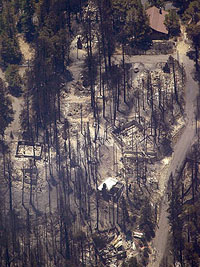 Of
course, wildfires wouldn't seem nearly so traumatic if people didn't
lose their homes, pets, lives and livelihoods. But as people have moved
from cities to more scenic locations, like on the edge of a forest,
more homes are at-risk for going up in flames than ever before. Even
if homeowners are lucky enough to weather the fire and smoke, the subsequent
mudslides could add up to some major repair bills.
Of
course, wildfires wouldn't seem nearly so traumatic if people didn't
lose their homes, pets, lives and livelihoods. But as people have moved
from cities to more scenic locations, like on the edge of a forest,
more homes are at-risk for going up in flames than ever before. Even
if homeowners are lucky enough to weather the fire and smoke, the subsequent
mudslides could add up to some major repair bills.
So since wildfire is part of the natural cycle of many ecosystems and since people aren't likely to give up their scenic views, how can wildfire best be managed?
This week, you'll look for clues to answer that question. You'll investigate wildfire's role in ecosystems and how wildfire starts and spreads. You'll also find out how wildfires are suppressed, along with how agencies use controlled burning techniques to help manage wildfire-prone areas.
The Nature of Wildfire
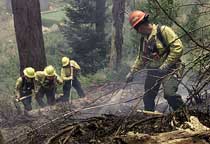 Begin
your investigation with an overview of wildfire — where it happens,
how it spreads, and how people fight it, at NOVA's Fire
Wars site. Make sure to click on any of the underlined
keywords to jump to its definition in the Glossary
of Fire Terms, then hit your browser's back button to return
to where you left off.
Begin
your investigation with an overview of wildfire — where it happens,
how it spreads, and how people fight it, at NOVA's Fire
Wars site. Make sure to click on any of the underlined
keywords to jump to its definition in the Glossary
of Fire Terms, then hit your browser's back button to return
to where you left off.
Start at The World on Fire section, which highlights how and why wildfire and prescribed fire (that is, controlled burning of fuels to reduce wildfire risk or boost soil nutrients) occurs in different regions of the world. Why do you think people began using fire to manage the landscapes in which they lived?
Continue with How Plants Use Fire, exploring how plants and wildlife have adapted to fire's presence across their habitats. What are some of the strategies species have evolved to resist, avoid or benefit from wildfire?
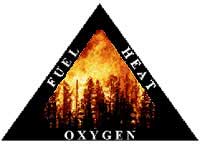 Next,
visit the On
Fire virtual lab (Flash or non-Flash) to strike a match
and discover how fire happens chemically. Which elements are involved
during the process? How exactly is a flame produced?
Next,
visit the On
Fire virtual lab (Flash or non-Flash) to strike a match
and discover how fire happens chemically. Which elements are involved
during the process? How exactly is a flame produced?
Before leaving NOVA, see what kinds of gear people use in the Outfitting Wildland Firefighters section through its Flash or non-Flash version. What kinds of conditions do firefighters face during a wildfire? What is important about each piece of equipment a firefighter carries into the field?
If you've got the Flash Player installed on your system, take look at what stokes a fire in the woods. At Firewise's Enhanced Media section, choose the Dynamics of Wildfire module, which will open in a pop-up window. Browse through it from the Introduction to Fire Types.
What are the three things a fire needs? What are the three elements of the behavior triangle, and how do they affect how wildfire might behave in an area? Can you describe the four different types of fires? What are "ladder fuels?"
You can keep tabs on the nation's wildfires throughout the year, or research seasons past, at the National Interagency Fire Center. Here, you can check the Wildland Fire Update and review Wildland Fire Statistics.
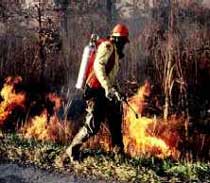 Managing
Fire
Managing
Fire
As you've learned, wildfire is important but can be difficult to manage. And, as you've also discovered, prescribed burning can help mitigate risk of a catastrophic wildfire and replenish soil health.
To explore what it might be like to be a fire manager — basically someone who decides when and where to do prescribed burning treatments — check out the Living with Fire game.
After reading the introduction and making any system adjustments, click to PLAY. This opens a new window that will cover your screen; just hit quit game any time to get out of it. This game is very interactive, so feel free to click on the team images when they show up, and any of the other options and topics. You can click back to game to pick up where you left off.
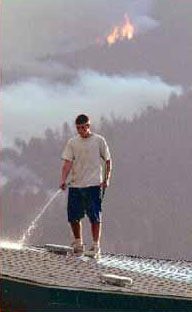 As
you play, you'll meet the Fire Management Team and be the one who decides
what to do with an old-growth or second-growth forest stand. Accompanying
team members can tell you what they think about the choices, and the
game will show you what happened to the stand based on your decision.
As
you play, you'll meet the Fire Management Team and be the one who decides
what to do with an old-growth or second-growth forest stand. Accompanying
team members can tell you what they think about the choices, and the
game will show you what happened to the stand based on your decision.
Although you may never become a fire manager on a national forest, you might be part of your home fire management team. So go back at the Firewise Enhanced Media site to investigate how you can help protect yourself and your neighbors from wildfire.Run through the Fire Hazard Assessment in the Wildland/Urban Interface module, along with the Home Rating Scale, Preparing a Home for Wildfire Season, Test Your Firewise IQ and Wildfire Approaching.
How well is your home prepared for wildfire? Can you identify any conditions that make your home more or less at-risk compared to those of your neighbors? If you live in an area with a low risk of wildfire, do you think you could live in a scenic rural location with a high risk of wildfire? What would the trade-offs be?
Newspaper Activities
Browse a current issue of Targetnewspaper to find stories about wildfires or people preparing for the possibility of wildfires in their area. If the article is about a fire, how did it start? How exactly are the elements of the fire triangles contributing to the spread of the fire? How are managers using their knowledge of fire behavior and the local conditions to create strategies for controlling it? If the stories are about people protecting their homes, what types of factors are they especially worried about? Have homeowners created a reasonable "defensible spaces" around their properties?
Since many of these fires occur on public lands, the federal and state governments are also concerned about wildfires. So find any stories about how these officials are managing forests now, and how new proposals could change their objectives or the ways they suppress fires. Do their comments and proposals make sense in light of the science and the nature of wildfire? Are there any nearby areas that are managed with prescribed burns?
© Copyright 2003
Learners Online, Inc.
